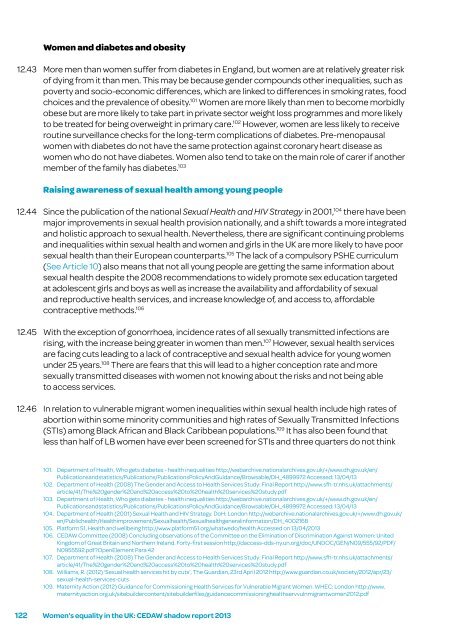Women’s equality in the UK – A health check
Women’s equality in the UK – A health check
Women’s equality in the UK – A health check
Create successful ePaper yourself
Turn your PDF publications into a flip-book with our unique Google optimized e-Paper software.
12.43<br />
12.44<br />
12.45<br />
12.46<br />
Women and diabetes and obesity<br />
More men than women suffer from diabetes <strong>in</strong> England, but women are at relatively greater risk<br />
of dy<strong>in</strong>g from it than men. This may be because gender compounds o<strong>the</strong>r <strong>in</strong>equalities, such as<br />
poverty and socio-economic differences, which are l<strong>in</strong>ked to differences <strong>in</strong> smok<strong>in</strong>g rates, food<br />
choices and <strong>the</strong> prevalence of obesity. 101 Women are more likely than men to become morbidly<br />
obese but are more likely to take part <strong>in</strong> private sector weight loss programmes and more likely<br />
to be treated for be<strong>in</strong>g overweight <strong>in</strong> primary care. 102 However, women are less likely to receive<br />
rout<strong>in</strong>e surveillance <strong>check</strong>s for <strong>the</strong> long-term complications of diabetes. Pre-menopausal<br />
women with diabetes do not have <strong>the</strong> same protection aga<strong>in</strong>st coronary heart disease as<br />
women who do not have diabetes. Women also tend to take on <strong>the</strong> ma<strong>in</strong> role of carer if ano<strong>the</strong>r<br />
member of <strong>the</strong> family has diabetes. 103<br />
Rais<strong>in</strong>g awareness of sexual <strong>health</strong> among young people<br />
S<strong>in</strong>ce <strong>the</strong> publication of <strong>the</strong> national Sexual Health and HIV Strategy <strong>in</strong> 2001, 104 <strong>the</strong>re have been<br />
major improvements <strong>in</strong> sexual <strong>health</strong> provision nationally, and a shift towards a more <strong>in</strong>tegrated<br />
and holistic approach to sexual <strong>health</strong>. Never<strong>the</strong>less, <strong>the</strong>re are significant cont<strong>in</strong>u<strong>in</strong>g problems<br />
and <strong>in</strong>equalities with<strong>in</strong> sexual <strong>health</strong> and women and girls <strong>in</strong> <strong>the</strong> <strong>UK</strong> are more likely to have poor<br />
sexual <strong>health</strong> than <strong>the</strong>ir European counterparts. 105 The lack of a compulsory PSHE curriculum<br />
(See Article 10) also means that not all young people are gett<strong>in</strong>g <strong>the</strong> same <strong>in</strong>formation about<br />
sexual <strong>health</strong> despite <strong>the</strong> 2008 recommendations to widely promote sex education targeted<br />
at adolescent girls and boys as well as <strong>in</strong>crease <strong>the</strong> availability and affordability of sexual<br />
and reproductive <strong>health</strong> services, and <strong>in</strong>crease knowledge of, and access to, affordable<br />
contraceptive methods. 106<br />
With <strong>the</strong> exception of gonorrhoea, <strong>in</strong>cidence rates of all sexually transmitted <strong>in</strong>fections are<br />
ris<strong>in</strong>g, with <strong>the</strong> <strong>in</strong>crease be<strong>in</strong>g greater <strong>in</strong> women than men. 107 However, sexual <strong>health</strong> services<br />
are fac<strong>in</strong>g cuts lead<strong>in</strong>g to a lack of contraceptive and sexual <strong>health</strong> advice for young women<br />
under 25 years. 108 There are fears that this will lead to a higher conception rate and more<br />
sexually transmitted diseases with women not know<strong>in</strong>g about <strong>the</strong> risks and not be<strong>in</strong>g able<br />
to access services.<br />
In relation to vulnerable migrant women <strong>in</strong>equalities with<strong>in</strong> sexual <strong>health</strong> <strong>in</strong>clude high rates of<br />
abortion with<strong>in</strong> some m<strong>in</strong>ority communities and high rates of Sexually Transmitted Infections<br />
(STIs) among Black African and Black Caribbean populations. 109 It has also been found that<br />
less than half of LB women have ever been screened for STIs and three quarters do not th<strong>in</strong>k<br />
101. Department of Health, Who gets diabetes - <strong>health</strong> <strong>in</strong>equalities http://webarchive.nationalarchives.gov.uk/+/www.dh.gov.uk/en/<br />
Publicationsandstatistics/Publications/PublicationsPolicyAndGuidance/Browsable/DH_4899972 Accessed: 13/04/13<br />
102. Department of Health (2008) The Gender and Access to Health Services Study: F<strong>in</strong>al Report http://www.sfh-tr.nhs.uk/attachments/<br />
article/41/The%20gender%20and%20access%20to%20<strong>health</strong>%20services%20study.pdf<br />
103. Department of Health, Who gets diabetes - <strong>health</strong> <strong>in</strong>equalities http://webarchive.nationalarchives.gov.uk/+/www.dh.gov.uk/en/<br />
Publicationsandstatistics/Publications/PublicationsPolicyAndGuidance/Browsable/DH_4899972 Accessed: 13/04/13<br />
104. Department of Health (2001) Sexual Health and HIV Strategy. DoH: London http://webarchive.nationalarchives.gov.uk/+/www.dh.gov.uk/<br />
en/Public<strong>health</strong>/Healthimprovement/Sexual<strong>health</strong>/Sexual<strong>health</strong>general<strong>in</strong>formation/DH_4002168<br />
105. Platform 51, Health and wellbe<strong>in</strong>g http://www.platform51.org/whatwedo/<strong>health</strong> Accessed on 13/04/2013<br />
106. CEDAW Committee (2008) Conclud<strong>in</strong>g observations of <strong>the</strong> Committee on <strong>the</strong> Elim<strong>in</strong>ation of Discrim<strong>in</strong>ation Aga<strong>in</strong>st Women: United<br />
K<strong>in</strong>gdom of Great Brita<strong>in</strong> and Nor<strong>the</strong>rn Ireland. Forty-first session http://daccess-dds-ny.un.org/doc/UNDOC/GEN/N09/555/92/PDF/<br />
N0955592.pdf?OpenElement Para 42<br />
107. Department of Health (2008) The Gender and Access to Health Services Study: F<strong>in</strong>al Report http://www.sfh-tr.nhs.uk/attachments/<br />
article/41/The%20gender%20and%20access%20to%20<strong>health</strong>%20services%20study.pdf<br />
108. Williams, R. (2012) ‘Sexual <strong>health</strong> services hit by cuts’, The Guardian, 23rd April 2012 http://www.guardian.co.uk/society/2012/apr/23/<br />
sexual-<strong>health</strong>-services-cuts<br />
109. Maternity Action (2012) Guidance for Commission<strong>in</strong>g Health Services for Vulnerable Migrant Women. WHEC: London http://www.<br />
maternityaction.org.uk/sitebuildercontent/sitebuilderfiles/guidancecommission<strong>in</strong>g<strong>health</strong>servvulnmigrantwomen2012.pdf<br />
122 <strong>Women’s</strong> <strong>equality</strong> <strong>in</strong> <strong>the</strong> <strong>UK</strong>: CEDAW shadow report 2013


